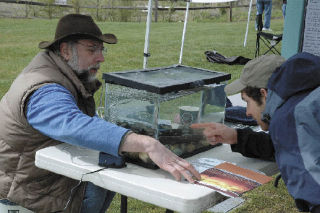MARYSVILLE — Obviously interrelated, water quality and salmon were probably the two most popular topics of discussion during the Earth Day celebration held April 19 along the city’s stretch of Ebey Slough.
Standing by a small aquarium filled with various types of young salmon, Kip Killebrew of the Stillaguamish Tribal Hatchery said everything from lawn fertilizers to the types of plants lining local waterways could affect local salmon. He added that unfortunately, hatcheries such as that run by the Stillaguamish are necessary to keep up the numbers of fish in local waters.
As many visitors seemed to know, Killebrew noted Chinook salmon are on the endangered species list. But he added Coho salmon aren’t doing very well either. One reason is the fish spend part of their lives in fresh water that Killebrew argued is, in general, far more affected by human behavior than salt water.
Visitor David Roon was among those who stopped by Killebrew’s Earth Day booth.
“I grew up around here,” Roon said, “and I wanted to see what kind of effort they’re doing to improve the local habitat.”
While pollution, rerouting and blocking of waterways are obvious factors affecting fish, Cara Ianni talked about how non-native plants are helping to choke out not just local vegetation, but salmon as well. Ianni was representing the non-profit Stilli-Snohomish Fisheries Enhancement Task Force.
Among the worst plant offenders, mentioned by several experts, is Scotch broom, those tall plants with the yellow flowers common along freeways.
A volunteer for People for Puget Sound, Karen Boyko said the arrival of Scotch broom in Washington dates all the way back to the time of Eleanor Roosevelt, who pushed for placing the plants along roadways because of their colorful appearance.
“The stuff is everywhere now,” Ianni said, also pointing to English ivy and English laurel as two others problematic plants. The non-local vegetation basically represents a sort of invading force, Ianni said, choking out local plants that just naturally fit better into the local ecosystem. Among other problems, the non-native plants don’t provide the right type of food or cover for wildlife.
Senior wetland ecologist for environmental consulting and landscape firm, the Jay Group, Kevin Karlson was among those who said foliage could affect the salmon population in a number of ways. Perhaps most importantly, salmon like cold water. When human development plans call for the removal of plantings along waterways, water temperatures rise as more sunlight hits the water.
Karlson also talked a lot about water quality. He said phosphates and nitrates are among the most threatening chemicals to local fish, especially salmon. Household detergents are the primary source of phosphates, which in theory should be removed by wastewater treatment facilities before the water is dumped back into local waterways. Almost needless to say, Karlson said that’s not always the case.
By the way, according to Karlson and others, the source of most nitrates includes garden and lawn fertilizers. Rains can carry the nitrates directly into local waterways. Karlson recommended not using fertilizer on your lawn, or if you must, try using an organic variety. To cut down on phosphates reaching waterways, he suggested not applying the suds to your car in your driveway, but heading for a car wash.
Incidentally, Karlson spent a good deal of Earth Day leading visitors through the steps to check local water quality for both nitrates and phosphates. He described Ebey Slough, which served as the backdrop for Marysville’s Earth Day celebration, as “surprisingly clean.”
Besides salmon and water quality, one other topic was a popular one amongst the activists and volunteers staffing the various Earth Day booths. While salmon get a lot of attention, crabs are another local species in trouble for various reasons. Representing the Beach Watchers group sponsored by Washington State University, Ann Uhl said her group has nothing against local crab fishermen. They do strongly advocate using biodegradable escape cords on crab pots.
According to Uhl, if pots become lost or abandoned, crabs end up trapped inside and eventually die off. Others come to feed and more and more crabs end up trapped and dying inside the lost pots. If a biodegradable escape cord is used, the crabs can get free of the pot if it is left untended for any extended length of time.
The problem might be bigger than you think. An intern with the Washington Conservation Corps, Amy Johnson said a sonar study of Port Gardner revealed 166 abandoned crab pots. Each can hold and trap up to 50 or 60 crab in a year. Johnson said there are plans to send divers to collect the pots from the port.
No one was quite sure how many folks attended this year’s Earth Day event, which probably suffered from much colder than average temperatures. This was the second Earth Day event sponsored by the city, according to the parks and recreation department’s Adam Bailey.
“Hopefully, it’ll just keep getting bigger and bigger,” Bailey said.
This year’s booths and exhibits spread from Ebey Slough Waterfront Park across the street and down to the city’s waste water treatment plant, where tours were available.



